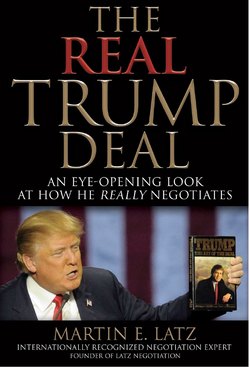Читать книгу The Real Trump Deal - Martin E. Latz - Страница 9
На сайте Литреса книга снята с продажи.
ОглавлениеPART ONE
TRUMP’S TOP 10 BUSINESS NEGOTIATION STRATEGIES
“I’m the first to admit that I am very competitive and that I’ll do nearly anything within legal bounds to win. Sometimes, part of making a deal is denigrating your competition.” 4
—Donald J. Trump, The Art of the Deal
Donald Trump started negotiating business deals almost 50 years ago in his early twenties. Named president of various Trump entities by his father, Fred, he negotiated leases and repair contracts for thousands of apartments in Trump-owned buildings.
Since then, Trump has negotiated in a wide variety of business contexts and with highly diverse counterparts. He considers negotiation part of his DNA, tweeting, “Deals are my art form. Other people paint beautifully or write poetry. I like making deals, preferably big deals. That’s how I get my kicks.” 5
He’s had massive successes and failures. What negotiation strategies and tactics has he consistently used? Donald Trump’s top ten most common strategies and tactics constitute the first ten chapters of this book.
To start, some preliminary notes:
Different Strategies Work in Different Environments. Sometimes the most effective negotiation strategy is to build the relationship. Other times an extremely aggressive approach works better. We will analyze Trump’s strategies in both contexts.
Trump’s Credibility Will Be Addressed Later. Trust, credibility, truthfulness, and parties’ reputations impact every negotiation. Some strategies involve bluffing, puffery, exaggeration, promises, threats, and other credibility-related moves. While we describe these here, chapter 12 extensively addresses their impact and effectiveness.
Trump Is Not a “One-Trick Pony.” Donald Trump uses more than these next ten strategies. However, these ten consistently pop up in his negotiations. They have likely become habits—so he will almost certainly continue to use them as President.
The Top Ten Order Is Based on the Five Golden Rules of Negotiation. Finally, the sequence here is not based on how often Trump uses these strategies, the order in which he implemented them, or their priority or power. Instead, they are organized around my Five Golden Rules of Negotiation, a strategic framework that describes the basic building blocks of the experts’ proven research.
Okay, here’s my Five Golden Rules structure and a short description of how Trump’s Top Ten Business Negotiation Strategies fit within them.
Golden Rule One: Information Is Power—So Get It!
The first thing to do in any negotiation is get sufficient information to set your goals. You cannot negotiate strategically based on the experts’ proven research without knowing where you want to end up and defining “success” at the end of the day.
In chapter one, we will evaluate a) how much Trump negotiates instinctively versus strategically and b) how and how much he prepares. These issues infuse the entire Trump approach to negotiations. We will shift in chapter two to exploring how his incredibly aggressive goal-setting and passionate expectations impact his deals.
Puffery and the role of “truthful hyperbole” will be addressed in chapter three. Trump exaggerates a lot. Does it work? Trump also regularly used the carrot-and-stick approach in his business negotiations. In chapter four, we look at the carrots he used to satisfy his interests.
Golden Rule Two: Maximize Your Leverage
Leverage—the most powerful component in negotiations—is based on two elements: 1) how much you and your counterpart need a deal, and 2) how well your deal, Plan A, stacks up to your best alternative, or Plan B. The better your Plan B, the stronger your leverage and vice versa.
Leverage makes its first significant appearance in chapter five. These were Trump’s sticks. Threats and bullying take center stage in chapters six and seven. Did they work?
Golden Rule Three: Employ “Fair” Objective Criteria
One word that most aptly describes Trump to many: unprecedented. Trump smartly used independent, objective standards like precedent, market value and experts to justify the “fairness” and “reasonableness” of his deals. We address these in Chapter eight.
Golden Rule Four: Design an Offer-Concession Strategy
Timing (when he makes his moves), speed (how often he makes his moves), and size (how big he makes his moves) comprise offer-concession strategies. Each move signals an important element in the negotiation “dance” that almost inevitably takes place between negotiation parties. Does Trump know this “dance”? This will be addressed in Chapter nine.
Golden Rule Five: Control the Agenda
If and when and how and where issues are addressed—and the timing and deadlines involved—greatly impact negotiation results. Chapter 10 focuses on how Trump controls the agenda in his business negotiations.
These first 10 chapters constitute Trump’s Top 10 Business Negotiation Strategies. Let’s see how Trump puts these into practice. Here’s a chart summarizing them.
FIVE GOLDEN RULES MAPPED TO TRUMP’S BUSINESS STRATEGIES
| FIVE GOLDEN RULES OF NEGOTIATION | TRUMP’S TOP TEN BUSINESS STRATEGIES |
| 1. Information Is Power—So Get It! | 1. An Instinctive Win-Lose Mindset |
| 2. Setting the Bar High: Super Aggressive Expectations | |
| 3. The King of Hyperbole: Exaggerate! | |
| 4. Targeting True Motivations: Using Carrots to Close Deals | |
| 2. Maximize Your Leverage | 5. The Art of the Bluff: When He Holds… and When He Folds |
| 6. Threats and Leverage: Real or Fake? | |
| 7. Business Bullying | |
| 3. Employ “Fair” Objective Criteria | 8. Helpful Standards Only Need Apply |
| 4. Design an Offer-Concession Strategy | 9. Outrageous Moves and Countermoves |
| 5. Control the Agenda | 10. A Towering Home-Field Agenda |
